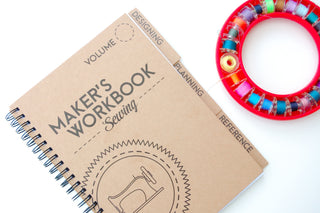Maker’s Workbook is a sewing journal which contains space to record the details of 25 sewing projects, get on top of your stash, and plan your future makes.

The A5 size workbook made of sturdy kraft card, it’s spiral bound so it comfortably lies flat on your workspace. Record all your sewing projects
A contents page made by you as you record your dressmaking projects! The workbook contains enough space for 25 projects.
This is where the action happens! Enough headers to gently guide you into making useful notes as you go along. Imagine your joy when you come to make your 2nd version (or 50th for that matter) of a garment and finding you don’t have to make all the same mistakes again. This useful sewing notebook helps you keep all the handy information together in one place.

And room for a little fabric swatch! What more could you want? 🙂
Design your future dressmaking projects, squared paper and a set of female body forms will help keep your doodles for ‘next time..’ all in one place.

Plan your next sewing project, make a record of the sewing patterns you have at home and log what fabric and haberdashery they require. Take your Maker’s Workbook with you and you’re all set for unexpectedly spying the perfect fabric on your travels, checking the pattern requirements (and not going home half a metre short!)
Of course there’s also room to list out your stashed fabrics and their sizes, keeping track of what’s in those boxes might stop duplications (no promises!)
Sewing reference, a quick run through of correct sewing machine needle for your fabric and a handy a metric to yard conversion!

